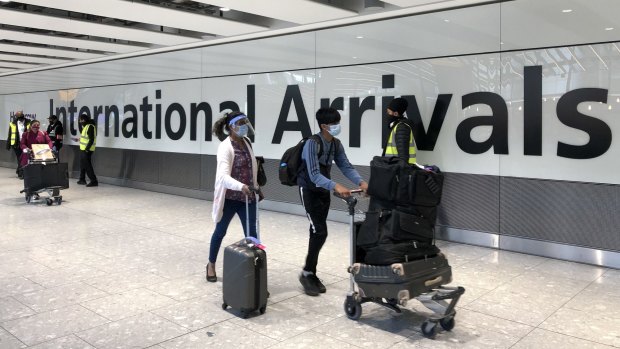This was published 2 years ago
Australia international border closures: Should we adopt the UK's 'traffic light' approach to arrivals?

Passengers arrive at London's Heathrow airport. The UK has introduced a 'traffic light' system for dealing with arrivals from different countries. Credit: Getty Images
Could the UK's new traffic light model for entry work for Australia?
The UK's handling of the coronavirus hasn't been a stellar success. Underestimating the severity of COVID-19, botching the response, failing to impose social distancing, contact tracing or mask wearing and allowing Brits to travel freely and return without quarantine until mid-2020 saw the UK record cataclysmic infection rates and more than a hundred thousand deaths from COVID-19.
Having acknowledged its failures, the UK government has now instituted an effective mass vaccination campaign and a revised border control strategy. From May 17, 2021, the UK is adopting a three-tier 'traffic light' system to determine who may enter and under what conditions.
The crucial factor is which countries incoming travellers have visited in the 10 days before arrival. Anyone seeking to enter the UK and who has been only in countries on the green list must take a COVID-19 PCR test on the second day after arrival. Apart from that, they're free to travel at will provided they abide by national restrictions governing, for example, social distancing and mask wearing.
Those who have been in any country on the amber list must quarantine in the place they're staying for 10 days and take a COVID-19 test on days two and eight.
Only British and Irish subjects, or those with UK residence rights, can enter the UK if they have been in a country on the red list in the previous 10 days. They must also quarantine for 10 full days in a managed quarantine hotel and take a COVID-19 test on days two and eight.
Along with 11 other countries, Australia will be included on the green list from May 17. However you would jeopardise that status if you were to arrive in the UK after a transit stop in Qatar or the UAE. Transit stops en route to the UK are considered 'visits', and all these countries are on the red list. If your transit stop took place in Singapore, which will join Australia on the green list, you could enter the UK and travel at will with only the requirement for a PCR test on day two.
How could this work here?
Before our government allows us to travel overseas for holidays and opens the door to let travellers from countries with low infection rates enter, it will need to modify our quarantine system.
Instead of the one-size-fits-all approach that consigns every incoming traveller to hotel quarantine – except for those currently coming from New Zealand – Australia will need to implement a graduated system that categorises incoming travellers based on where they're coming from. The UK model with its three-tier traffic light system is simple and fit for purpose, but it could be improved.
Right now, anyone travelling to Australia must be tested for COVID-19 within 72 hours prior to flight departure, and show evidence of a negative result at the airline's check-in desk. That needs to stay in place.
Hotel quarantine for incoming travellers is a band-aid, not a long-term solution, and it's proven to be a leak in our defences. Dedicated quarantine facilities with trained staff are required. If Australia can transition to home-based quarantine for residents returning from countries on the amber list, that should limit the need for extensive dedicated facilities.
When could this happen?
Latest indications are that the Australian government does not intend to relax restrictions to allow overseas leisure travel until mid-2022. Key to the relaxation of border controls is the COVID-19 vaccination program. Until our population is sufficiently vaccinated to achieve herd immunity, the government is not likely to open borders either to welcome international travellers or to allow Australian residents to travel freely without the need to quarantine on return.
With respect to its vaccination rollout, Australia's performance has been woeful. The UK has now fully vaccinated over 27 per cent of its population, second only to the USA. For Singapore the figure is 22.5 per cent. France, 12.1 per cent, Mongolia 19.6 per cent. As of May 12, 2021, Australian residents have been given 2.8 million vaccine doses. The Department of Health isn't revealing how many Australians have been fully vaccinated but the overwhelming majority have received only one dose. Anything like herd immunity is still a long way off.
Having botched the vaccine rollout, the government needs to keep us locked in, and the rest of the world locked out. Anyone who wants to travel overseas for a holiday has become collateral damage for the government's ineptitude.
It also comes at a cost. The tourism industry and the education sector have taken a massive hit from the border closures. As long as those closures are in force the government will face continuing pressure to prop up the tourism industry, and shouts from Qantas for more hundreds of millions of taxpayer dollars.
See also: Soon we'll no longer feel sorry for Americans, we'll envy them
See also: What most people don't get about our international borders debate
Sign up for the Traveller newsletter
The latest travel news, tips and inspiration delivered to your inbox. Sign up now.